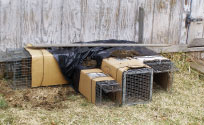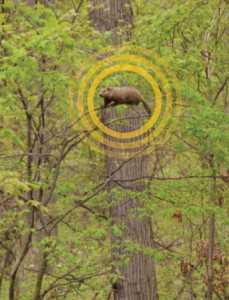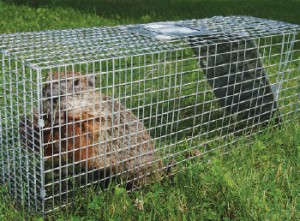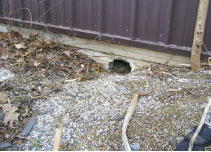Biology, behavior and control tips to turn woodchuck problems into profits
Woodchucks are short, stocky ground squirrels that weigh an average of 5 to 10 lbs. Their dark brown tail contrasts with the light brown fur on their body. Their front feet have long claws that allow them to excavate burrows as long as 66 ft. They have two kinds of den entrances: The main entrance has a porch, which consists of excavated soil pushed out in front of it, and hidden escape holes, which lack the soil porch of the main hole. Entrances range from one for newly constructed dens and as many as five for older dens.
They prefer to live in fields bordered by woods. Human-caused changes in habitat have allowed woodchucks to extend their range westward into the Great Plains. They emerge from hibernation in February or March. Mating occurs in March or April, and females give birth to two to four young 32 days later. Young disperse to find their own homes in July.
Woodchucks harm property by:
- undermining levees, foundations and pools because of burrowing;
- ravaging gardens because of their need to put on hibernation fat; and
- damaging tree bark, which reduces fruit-tree production, because of their marking behavior.
Control strategies
Exclusion
Fences provide the best way to protect gardens, sheds and decks. Select half-inch hardware cloth that has been galvanized after the weld. Garden fences should be at least 4 ft. tall and include a 90° bend consisting of a 12-in.-wide apron buried 2 in. below the soil surface and extending outward from the vertical fence. The apron prevents woodchucks from burrowing under the fence. Because woodchucks also climb, one might need to extend the fence higher or add a 45° angle overhang. Use similar principles for protecting decks and sheds. Remind customers this screening will prevent skunks from taking up residence.
Repellents
Research by Purdue University’s Dr. Rob Swihart found that spraying trees with bobcat (Lynx rufus) urine reduced woodchuck gnawing damage to those trees by 98 percent. The treatment was effective for as long as 93 days. Other researchers have found that spraying a single-strand rope fence with bobcat urine could reduce woodchuck damage by 90 percent.
Cage trapping
Woodchucks can be trapped in double-door (minimum size 8x8x30 in.) or single-door traps (minimum size 10x12x32 in.). Use double-door traps when you have access to den entrances. Barricade them in a manner so that, as the woodchuck emerges from the den, the only light it sees is through the trap. Ideally, double-door traps should be set at night. If that isn’t possible, place a baited trap nearby in case the woodchuck was outside the den when you set the double-door trap. Single-door traps should be baited with apples, romaine lettuce, cantaloupe, and professional lures and baits. Place traps along trails or areas where woodchucks frequent the property. Keep bait fresh and be patient because woodchucks often avoid new objects for a few days. Be sure technicians can handle skunks that might be caught.
[ RELATED LINK: Special Woodchuck Bait ]
Fumigants
Charcoal-sulfur cartridges are registered for use on woodchuck dens away from structures. These cartridges are effective when these three best practices are followed:
- Locate all the den entrances, starting with the main entrance (the one with the porch). Walk in concentric circles emanating away from the first hole out to a distance of no more than 100 ft. Watch where you step because you can easily twist an ankle falling into an escape hole. As a general rule, escape holes are within 50 ft. of the first hole; but search the extra distance to be sure.
- Tape a fumigant cartridge to the end of a 2- to 3-ft.-long stick for every hole. The stick allows you to place the cartridge deep into the burrow, so you won’t bury it when you backfill the hole.
- Avoid gassing until sunset to ensure the woodchuck is in the den. With a shovel handy, light the fuse and insert the cartridge fuse-first as far into the den as possible. Refill the hole quickly. It’s essential to keep as much gas inside the den as possible. Do the same for the other hole(s). Warn your clients about the toxic nature of the gas, and don’t allow them to stand nearby. Avoid exposing yourself to the fumes. Even though the gas is heavier than air and tends to hug the ground, it will give you a foggy head and can kill you if you breathe too much of it. After gassing, tell the owner to check the holes in three days. If the holes aren’t reopened, the animals likely died in the den.
Fumigants frequently fail when the woodchuck isn’t present or when gas concentrations don’t achieve sufficient strength. Gas concentration can be affected by various factors, such as den size, porousness of the soil, failure of the cartridge to burn completely, etc. Fumigation is more effective after a rain because the water fills the gaps in the soil, making the den emit less toxic gas. Rain also reduces fire risk. Remember, woodchucks are tough critters. One trapper bombed a den and three days later, the chucks threw out their dead.
Propane-oxygen exploders

Find den entrances and barricade them with single or double-door traps. (Photo courtesy of Stephen M. Vantassel, CWCP)
Propane-oxygen exploders are a relatively new tool for use against woodchucks. They pump propane and oxygen into the burrow, which is then detonated. Buy and use safety equipment. Contact your local authorities to ensure the detonation won’t affect natural gas lines, sewers or other underground utilities or objects. Fill times will range from 15 to 60 seconds. Large dens in loamy or sandy soil might require fill times of 90 to 120 seconds. Start at the low end, and monitor jobs to determine average effective fill times in your area. Backfill holes, and monitor for digouts as you would with fumigation. Not all states permit using explosive devices for killing wildlife. While these regulations were intended to stop kids from fishing with pipe bombs, the unintended consequence of these rules prevents the legal use of a legitimate tool. This is another reason why professionals need to join associations to press for rational and science-based regulations for our industry. pmp
Vantassel is a contributor for PMP and can be reached at stephenvantassel@hotmail.com.



Leave A Comment